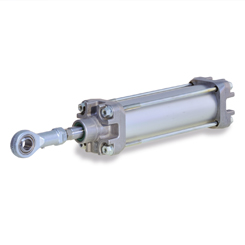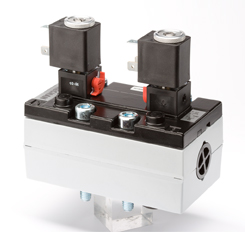Pneumatics


Pneumatic drive technology is ideal for high speeds with low forces, as its operating substance is gaseous and therefore compressible. It is available constantly and without limitation as ambient air. Unlike hydraulics, where a closed circuit is required, there is also no need for recirculation of the air after the working member has been activated.
A further advantage of pneumatics over hydraulics is that the air has a faster velocity of flow. The speed is 10-15 m/s. With pneumatics, cylinders can reach an operating speed of the cylinder of up to 300 m/min. With hydraulics, the speed is limited to about 30-60 m/min.
Pneumatic switches are comparable with electronics in terms of the range of possibilities they provide and, unlike electronics, they are not sensitive to outside influences. This means that pneumatics are resistant to high variations in temperature, impact stress and also (partially) dirt. They can also be used in a corrosive environment or in areas exposed to radiation. Pneumatic installations are also suited for application in areas where there is a risk of explosion as in most cases they do not increase the risk of explosion.
As a result, pneumatic technology is very common. Pneumatics can be found in air brakes, rail engineering and tools operated by compressed air as well as in conveying and positioning equipment.
However, the compressibility of air is also associated with disadvantages. It means that signal transmission in pneumatic systems is limited to a distance of approx. 200m.
The speed of the signal transmission is limited to the speed of sound. This means there are clear disadvantages compared to electronic systems.
At 12 bar, the maximum energy density for pneumatics is much lower than for hydraulic installations. Whilst in pneumatics, pressures of a maximum of 12 bars can be worked with, with hydraulics, pressures of between 30 and 315 bar are common and in special applications (mostly clamping processes), pressures of up to 700 bar can be reached.
Pneumatic controls are usually made up of a control system and a drive or work element. In the control element, mechanical and electrical or pneumatic signals are registered and processed further. The behaviour of the drive members, which are usually made from compressed air cylinders or air motors, depends on the output signals emitted by the control element.
Drive Members (Cylinders and Motors)
Pneumatic cylinders and pneumatic motors are the two pneumatic components which transform pneumatics into mechanical energy. They are also called working members and they make up the link between pneumatics and the machine tool.
- Cylinders for linear movements (e.g. for tensioning)
- Cylinders with transmission for pivoting
- Compressed air motors for rotational movements
In control technology, linear drives in the form of cylinders are normally used and are used e.g. for the clamping and feeding of workpieces in machining centres or in the sealing of packaging.
Control Systems (Valves)
In pneumatics, valves are used as actuators which control the work members.
The following valve types are available:
- Directional valves,
- Check valves,
- Pressure control valves,
- Flow control valves and
- Special valves (e.g. proportional valves).
